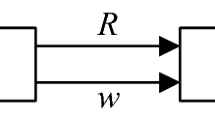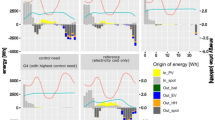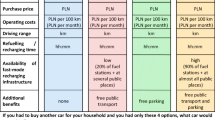Abstract
Consumers may anticipate regret when making purchasing decisions on a battery-charging vehicle (CV) or a battery-switching vehicle (SV). They anticipate a revolutionary regret when purchasing SVs with an extra switching function but a higher price, and a conservative regret at a lower price but only a charging function. This study investigates whether and how anticipated regret affects competing manufacturers’ price and quality. We find that SV demand is always higher than CV demand, and anticipated regret always promotes electric vehicle (EV) adoption. Interestingly, the revolutionary regret discourages the development of the extra battery-switching function and weakens the consumer’s preference for SVs. Then, the presence of only revolutionary regret causes a lose–lose situation where SV manufacturers reduce the quality level of the additional battery-switching attribute and thus intensify price competition for both manufacturers. SV sales cannibalize CV demand when consumers anticipate revolutionary regret. Moreover, the presence of only conservative regret has no impact on SV manufacturers, but affects CV manufacturers. When EV charging is convenient for consumers, CV manufacturers benefit from conservative regret; otherwise, CV manufacturers quit the market. Finally, when two kinds of regret coexist, the profits of both manufacturers are lower than when there is no regret and only conservative regret, but they are higher than when there exists only revolutionary regret. The results not only contribute to guiding the manufacturer to invoke or mitigate consumers’ anticipated regret, but also provide advice to show or hide this regret for consumers.






Similar content being viewed by others
Data availability
The authors confirm that the data supporting the findings of this study are available within the paper and its appendix.
Notes
Tesla launched battery-switching technology in 2013, but did not commercialize it and gave up developing this technology. As of 2021, the number of CV and SV is 6.4 million and 0.25 million in China, respectively.
References
Abouee-Mehrizi, H., Baron, O., Berman, O., & Chen, D. (2020). Adoption of electric vehicles in car sharing market. Production and Operations Management, 30, 190–209.
Ajanovic, A., & Haas, R. (2018). Electric vehicles: Solution or new problem? Environment, Development and Sustainability, 20, 7–22.
Alp, O., Tan, T., & Udenio, M. (2022). Transitioning to sustainable freight transportation by integrating fleet replacement and charging infrastructure decisions. Omega, 109, 102595.
AskCI, 2022. Forecasting and analysis of the number and competition pattern of China's battery switching stations of new energy vehicles in 2022.
Avci, B., Girotra, K. & Netessine, S. (2014). Electric Vehicles with a Battery Switching Station: Adoption and Environmental Impact. Management Science, 61(4), 772–794.
Chen, X., Xing, K., Ni, F., Wu, Y.J. & Xia, Y.X. (2021). An Electric Vehicle Battery-Swapping System Concept, Architectures, and Implementations. Ieee Intelligent Transportation Systems Magazine, 14(5), 175–194.
Chen, Y., & Turut, Ö. (2013). Context-dependent preferences and innovation strategy. Management Science, 59, 2747–2765.
Consul, S., Singh, K.V., Bansal, H.O. & Kim, K.A. (2022). Intelligent switching mechanism for power distribution in photovoltaic-fed battery electric vehicles. Environment Development and Sustainability. https://doi.org/10.1007/s10668-022-02398-0
Diecidue, E., Rudi, N., & Tang, W. J. (2012). Dynamic purchase decisions under regret: Price and availability. Decision Analysis, 9, 22–30.
Eberle, U. & von Helmolt, R. (2010). Sustainable transportation based on electric vehicle concepts: a brief overview. Energy & Environmental Science, 3(6), 689–699.
Gu, Q., Zhang, R., & Liu, B. (2023). Pricing and advertising decisions in O2O supply chain with the presence of consumers anticipated regret. Journal of Business & Industrial Marketing, 38, 1135–1149.
Ha, Y. (2018). Expectations gap, anticipated regret, and behavior intention in the context of rapid technology evolvement. Industrial Management & Data Systems, 118, 606–617.
Hu, T., Ma, H., Sun, H., & Liu, K. (2023). Electrochemical-theory-guided modeling of the conditional generative adversarial network for battery calendar aging forecast. IEEE Journal of Emerging and Selected Topics in Power Electronics, 11, 67–77.
IEA. (2022). Electric Vehicles. IEA.
iResearch, 2022. 2022 China new energy vehicle battery switching market research report. https://report.iresearch.cn/content/2022/05/430554.shtml
Jiang, B. J., Narasimhan, C., & Turut, O. (2017). Anticipated regret and product innovation. Management Science, 63, 4308–4323.
Jiang, J., Zhang, L., Wen, X., Valipour, E., & Nojavan, S. (2022). Risk-based performance of power-to-gas storage technology integrated with energy hub system regarding downside risk constrained approach. International Journal of Hydrogen Energy, 47, 39429–39442.
Jin, Q., Zhu, M., Yang, Y., & Liu, L. (2022). Consumer search with anticipated regret. Production and Operations Management, 31, 3337–3351.
Ko, H., Pack, S., & Leung, V. C. M. (2022). An optimal battery charging algorithm in electric vehicle-assisted battery swapping environments. IEEE Transactions on Intelligent Transportation Systems, 23, 3985–3994.
Levinson, R. S., & West, T. H. (2018). Impact of convenient away-from-home charging infrastructure. Transportation Research Part D-Transport and Environment, 65, 288–299.
Li, Y., Zhang, P., & Wu, Y. (2018). Public recharging infrastructure location strategy for promoting electric vehicles: A bi-level programming approach. Journal of Cleaner Production, 172, 2720–2734.
Lin, L., Shi, J., Ma, C., Zuo, S., Zhang, J., Chen, C., & Huang, N. (2023). Non-intrusive residential electricity load decomposition via low-resource model transferring. Journal of Building Engineering, 73, 106799.
Liu, Z.F., Wang, Y.J. & Feng, J. (2022). Vehicle-type strategies for manufacturer's car sharing. Kybernetes. https://doi.org/10.1108/K-11-2021-1095
Liu, B. Q., Pantelidis, T. P., Tam, S., & Chow, J. Y. J. (2022). An electric vehicle charging station access equilibrium model with M/D/C queueing. International Journal of Sustainable Transportation, 17, 228–244.
Liu, Z., Feng, J., & Uden, L. (2023). From technology opportunities to ideas generation via cross-cutting patent analysis: Application of generative topographic mapping and link prediction. Technological Forecasting and Social Change, 192, 122565.
Mourali, M., Yang, Z. Y., Pons, F., & Hassay, D. (2018). Consumer power and choice deferral: The role of anticipated regret. International Journal of Research in Marketing, 35, 81–99.
Mussa, M., & Rosen, S. (1978). Monopoly and product quality. Journal of Economic Theory, 18, 301–317.
Nasiry, J., & Popescu, I. (2012). Advance selling when consumers regret. Management Science, 58, 1160–1177.
NIO, 2021. The process of the battery switching only takes 3–5 minutes.
Niu, B. Z., Dai, Z. P., & Li, Q. Y. (2022). Sharing knowledge to an entrant for production investment confronting COVID-19: Incentive alignment and lose-lose dilemma. Risk Analysis, 42, 177–205.
Ouyang, X., & Xu, M. (2022). Promoting green transportation under the belt and Road Initiative: Locating charging stations considering electric vehicle users’ travel behavior. Transport Policy, 116, 58–80.
Ruan, J. G., Walker, P. D., Zhang, N., & Wu, J. L. (2017). An investigation of hybrid energy storage system in multi-speed electric vehicle. Energy, 140, 291–306.
Saboori, H., & Jadid, S. (2022). Mobile battery-integrated charging station for reducing electric vehicles charging queue and cost via renewable energy curtailment recovery. International Journal of Energy Research, 46, 1077–1093.
Schloter, L. (2022). Empirical analysis of the depreciation of electric vehicles compared to gasoline vehicles. Transport Policy, 126, 268–279.
Schneider, F., Thonemann, U. W., & Klabjan, D. (2018). Optimization of battery charging and purchasing at electric vehicle battery swap stations. Transportation Science, 52, 1211–1234.
Singh, A., & Letha, S. S. (2019). Emerging energy sources for electric vehicle charging station. Environment, Development and Sustainability, 21, 2043–2082.
Sun, B., Sun, X., Tsang, D. H. K., & Whitt, W. (2019). Optimal battery purchasing and charging strategy at electric vehicle battery swap stations. European Journal of Operational Research, 279, 524–539.
Tan, X. Q., Qu, G. N., Sun, B., Li, N., & Tsang, D. H. K. (2019). Optimal scheduling of battery charging station serving electric vehicles based on battery swapping. IEEE Transactions on Smart Grid, 10, 1372–1384.
Tirole,. (1988). The theory of industrial organization. MIT Press.
Tran, C. Q., Keyvan-Ekbatani, M., Ngoduy, D., & Watling, D. (2021). Stochasticity and environmental cost inclusion for electric vehicles fast-charging facility deployment. Transportation Research Part E: Logistics and Transportation Review, 154, 102460.
Xiao, D., An, S., Cai, H., Wang, J., & Cai, H. M. (2020). An optimization model for electric vehicle charging infrastructure planning considering queuing behavior with finite queue length. Journal of Energy Storage, 29, 10.
Yang, J., & Sun, H. (2015). Battery swap station location-routing problem with capacitated electric vehicles. Computers & Operations Research, 55, 217–232.
Yang, W. H., Wang, H., Wang, Z. J., Fu, X. L., Ma, P. C., Deng, Z. C., & Yang, Z. H. (2020). Optimization strategy of electric vehicles charging path based on “traffic-price-distribution” mode. Energies, 13, 26.
Zeelenberg, M. (1999). Anticipated regret, expected feedback and behavioral decision making. Journal of Behavioral Decision Making, 12, 93–106.
Zeelenberg, M., Beattie, J., van der Pligt, J., & de Vries, N. K. (1996). Consequences of regret aversion: Effects of expected feedback on risky decision making. Organizational Behavior and Human Decision Processes, 65, 148–158.
Zhang, X., Wang, Y., Yuan, X., Shen, Y., Lu, Z., Wang, Z. (2022). Adaptive dynamic surface control with disturbance observers for battery/supercapacitor-based hybrid energy sources in electric vehicles. IEEE Transactions on Transportation Electrification, 1–1. https://doi.org/10.1109/TTE.2022.3194034
Zhao, X., Peng, B., Zheng, C., & Wan, A. (2022). Closed-loop supply chain pricing strategy for electric vehicle batteries recycling in China. Environment, Development and Sustainability, 24, 7725–7752.
Zheng, X. M., Menezes, F., Zheng, X. F., & Wu, C. K. (2022). An empirical assessment of the impact of subsidies on EV adoption in China: A difference-in-differences approach. Transportation Research Part a-Policy and Practice, 162, 121–136.
Acknowledgements
The authors gratefully acknowledge support from Shanghai Science and Technology Program (Project No. 21692109000, 22692113300).
Author information
Authors and Affiliations
Contributions
JF was involved in conceptualization, formal analysis; YW helped in methodology; ZL contributed to project administration; YW was involved in resources, writing—original draft; ZL and JF helped in writing—review & editing.
Corresponding author
Ethics declarations
Conflict of interest
The authors declare that there is no conflict of interest regarding the publication of this paper.
Additional information
Publisher's Note
Springer Nature remains neutral with regard to jurisdictional claims in published maps and institutional affiliations.
Supplementary Information
Below is the link to the electronic supplementary material.
Rights and permissions
Springer Nature or its licensor (e.g. a society or other partner) holds exclusive rights to this article under a publishing agreement with the author(s) or other rightsholder(s); author self-archiving of the accepted manuscript version of this article is solely governed by the terms of such publishing agreement and applicable law.
About this article
Cite this article
Liu, Z., Wu, Y. & Feng, J. Competition between battery switching and charging in electric vehicle: considering anticipated regret. Environ Dev Sustain 26, 11957–11978 (2024). https://doi.org/10.1007/s10668-023-03592-4
Received:
Accepted:
Published:
Issue Date:
DOI: https://doi.org/10.1007/s10668-023-03592-4




